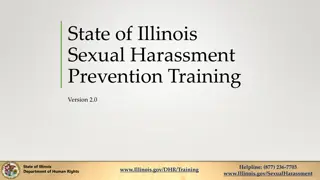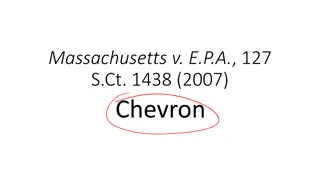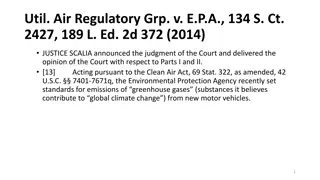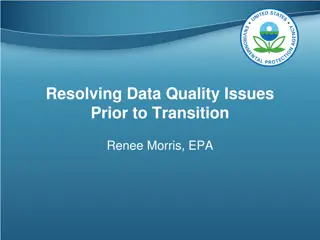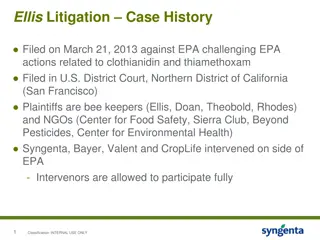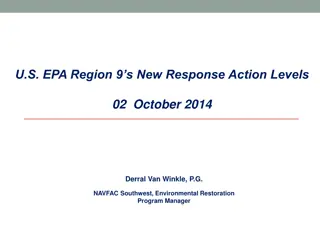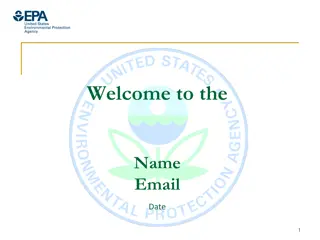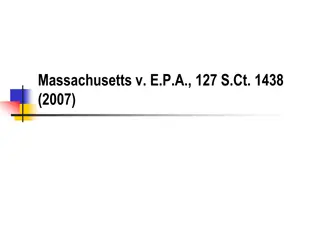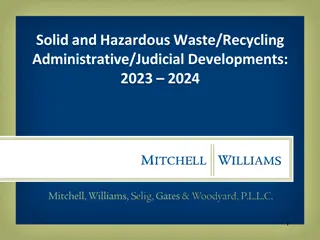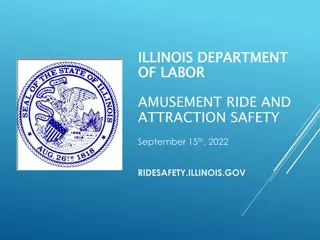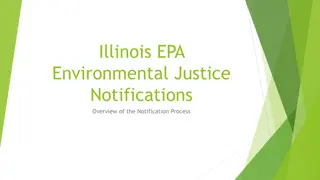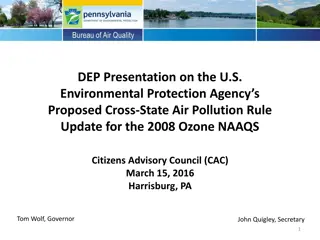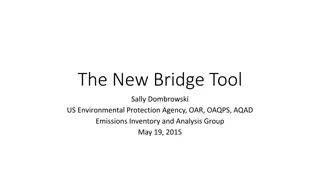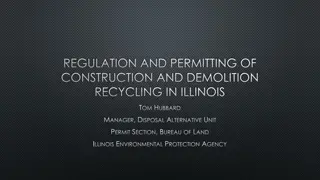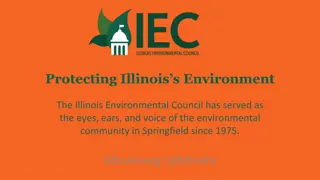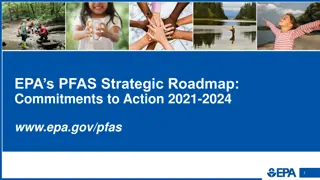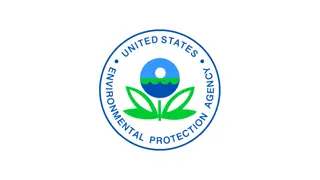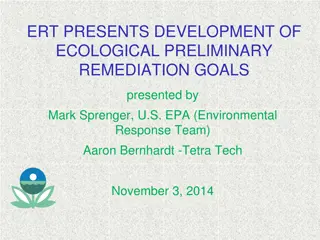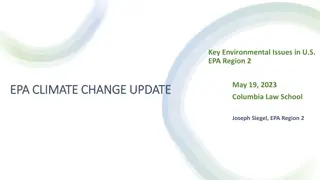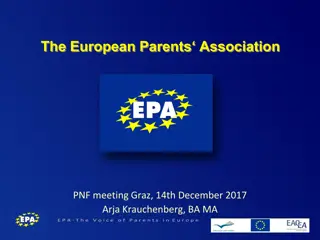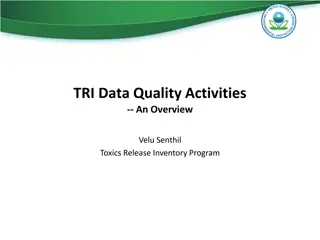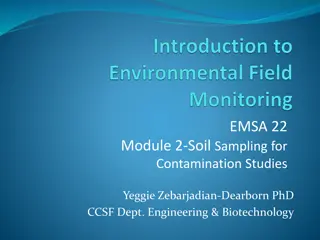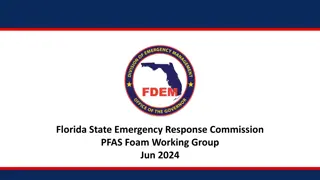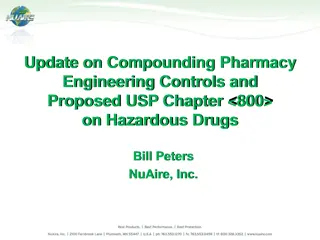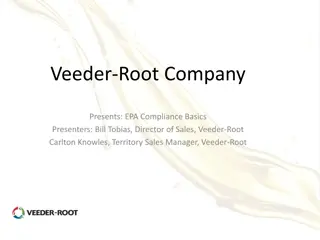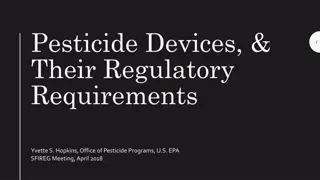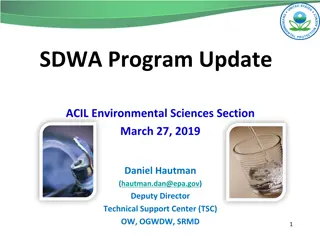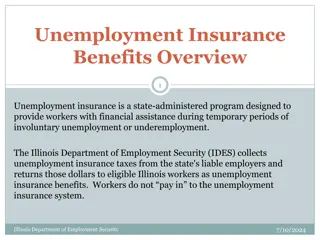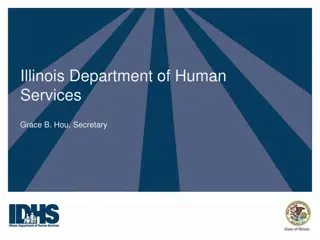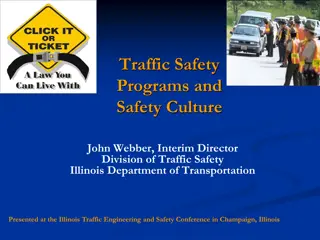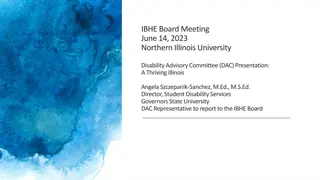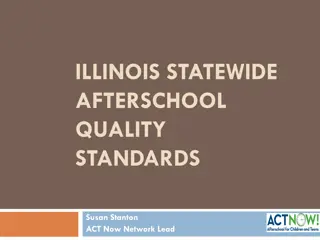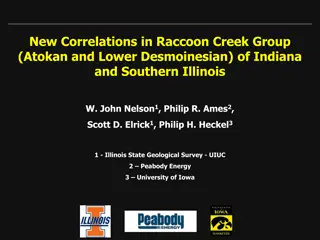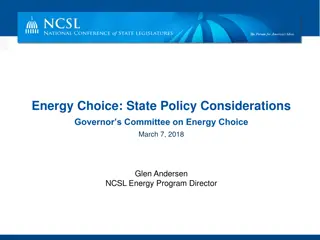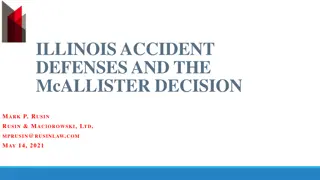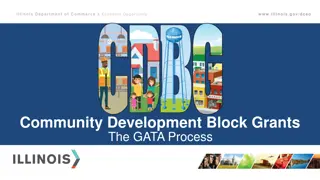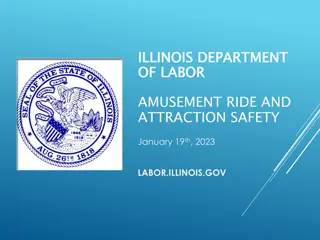Proposed Updates to Illinois EPA Regulations
The Illinois Environmental Protection Agency has proposed updates to 35 Ill. Adm. Code 620, focusing on definitions, analytical methods, groundwater classification, and preventive response activities. The changes aim to reflect updated terminology, incorporate new references, and enhance protective measures for groundwater resources. Written comments are welcome until June 25, 2021, with submissions directed to EPA620.rulemaking@illinois.gov.
Download Presentation

Please find below an Image/Link to download the presentation.
The content on the website is provided AS IS for your information and personal use only. It may not be sold, licensed, or shared on other websites without obtaining consent from the author. Download presentation by click this link. If you encounter any issues during the download, it is possible that the publisher has removed the file from their server.
E N D
Presentation Transcript
Illinois Environmental Protection Agency Proposed Updates to 35 Ill. Adm. Code 620 Written comments must be received by the Illinois EPA by June 25, 2021. Comments must be submitted to EPA.620.rulemaking@illinois.gov.
Agenda Opening Remarks Overview of Changes Bureau of Water-Lynn Dunaway Associate Director s Office (Toxicology)-Carol Hawbaker Q&A with Panelist Department of Legal Counsel- Sara Terranova Bureau of Land-Greg Dunn Bureau of Water- Michael Brown Bureau of Water-Lynn Dunaway Associate Director s Office (Toxicology)-Carol Hawbaker Closing Remarks
Proposed Changes to 35 Ill. Adm. Code Part 620 May 2021
Agenda Opening Remarks Overview of Changes Bureau of Water-Lynn Dunaway Associate Director s Office (Toxicology)-Carol Hawbaker Q&A with Panelist Department of Legal Counsel- Sara Terranova Bureau of Land-Greg Dunn Bureau of Water-Lynn Dunaway Associate Director s Office (Toxicology)-Carol Hawbaker Closing Remarks
Proposed Changes Subparts A and B Section 620.110 Definitions Definitions have been added to reflect updated terminology Delete obsolete terms Section 620.125 Incorporations by Reference Update reference to USEPA documents New and updated analytical methods Update sample collection procedures Section 620.210 Class I: Potable Resource Groundwater Added delineated wellhead protection areas as Class I groundwater areas Eliminated permeameters as a method to determine hydraulic conductivity for groundwater classification Section 620.250 Groundwater Management Zone Added a list of information that must be provided with a GMZ application
Proposed Changes Subpart C Section 620.302 Applicability of Preventive Notice and Preventive Response Activities Added additional examples of programs conducting groundwater monitoring Section 620.310 Preventive Response Activities Tabulated lists of chemicals Added chemical abstract numbers for reference Eliminated chemicals which are now considered carcinogens Added proposed chemicals to which Preventive Response will apply Replaced outdated analytical references with updated references
Proposed Changes Subpart D Section 620.410 Groundwater Quality Standards for Class I: Potable Resource Groundwater Tabulated lists of chemicals Added chemical abstract numbers for reference Added proposed chemicals Updated numerical groundwater standards to reflect MCLs Update numerical groundwater standards with the proposed criteria for establishing health-based concentrations (Carol Hawbaker will discuss these proposed changes further) Added footnotes describing the origin of the numerical groundwater standard Section 620.420 Groundwater Quality Standards for Class II: General Resource Groundwater Tabulated lists of chemicals Added chemical abstract numbers for reference Added proposed chemicals Updated numerical groundwater standards to reflect updated treatment efficiencies Added footnotes describing the origin of the numerical groundwater standard
Proposed Changes Subpart D Section 620.430 Groundwater Quality Standards for Class III: Special Resource Groundwater Site-specific standards for chloride and pH within the designated Class III Groundwater areas of four Dedicated Nature Preserves that are cave systems Site-specific standards for chloride within the designated Class III Groundwater areas of two Dedicated Nature Preserves that are wetlands Section 620.440 Groundwater Quality Standards for Class IV: Other Groundwater Updated names of previously regulated chemicals Section 620.450 Alternative Groundwater Quality Standards Updated names of previously regulated chemicals
Proposed Changes Subparts E and F Section 620.510 Monitoring and Analytical Requirements Simplify citation to Section 620.125 Add new subsection for statistical methods document contained in Section 620.125 Update analytical method references Section 620.601 Purpose of a Health Advisory Update citation to applicable regulations Section 620.605 Issuance of a Health Advisory Update references to guidance Update analytical method references
Written comments must be received by the Illinois EPA by June 25, 2021. Comments must be submitted to EPA.620.rulemaking@illinois.gov. Thank You For Your Participation!
A picture containing room Description automatically generated Illinois Environmental Protection Agency Proposed Updates to 35 Ill. Adm. Code 620 By: Carol Hawbaker Environmental Risk Assessor Illinois Environmental Protection Agency Office of Toxicity Assessment May 26, 2021
Proposed Updates to 35 Ill. Adm. Code 620 The presentation will cover the following topics: Introduction of nine new constituents. Addition of three metabolites to be evaluated with atrazine for compliance with groundwater quality standards (GQS). Combination of radium 226 and radium 228 to form a new constituent: radium (combined 226+228). Addition of carcinogen designations for four existing constituents. Updates to constituents in the tables at Section 620.310(a)(3)(A)(i) and (ii).
Proposed Updates to 35 Ill. Adm. Code 620 The presentation will cover the following topics (continued): Updates of Class I GQS for three inorganic constituents from MCLs to irrigation/livestock water quality standards, based on beneficial use of groundwater. For constituents which Class I GQS are based on procedures found in Section 620, Subpart F and Appendix A: Updates to toxicity values and relative source contribution (RSC) values; Updates to exposure factors; Addition of a mutagenic method for the development of a carcinogen Class I GQS for constituents with a mutagenic mode of action.
Proposed Updates to 35 Ill. Adm. Code 620 The presentation will cover the following topics (continued): Updates to Class II GQS. Introduction of tables (Appendix E) listing constituents that have similar-acting health effects or affect the same target organ.
Introduction of New Constituents Five Per-and Polyfluoroalkyl Substances (PFAS): Aluminum Lithium PFBS (Perfluorobutanesulfonic Acid) 1-Methylnaphthalene PFHxS (Perfluorohexanesulfonic Acid) Molybdenum PFNA (Perfluorononanoic Acid) PFOA (Perfluorooctanoic Acid) PFOS (Perfluorooctanesulfonic Acid)
Introduction of New Constituents Proposed Class I and Class II GQS: Proposed Class I GQS (mg/L) Proposed Class II GQS (mg/L) 5 2.5 0.27 0.05 Class I Source Class II Source Livestock Irrigation Subpart F Irrigation CASRN Constituent 1.9 0.01 0.27 0.019 Subpart F Subpart F Subpart F Subpart F 7429-90-5 Aluminum 7439-93-2 Lithium 90-12-0 7439-98-7 Molybdenum 1-Methylnaphthalene
Per and Poly-Fluoroalkyl Substances (PFAS) PFAS are a group of human-made constituents applied to many consumers products to make them waterproof, stain resistant or non-stick. Food packaging - fast food containers, lunch meat paper, disposable plates and bowls, and oil-, water- and grease-resistant coatings on food packaging (pizza boxes); Commercial household products - non-stick coated cookware (Teflon), cleaning products, waxes, polishes, and adhesives; Clothing and fabric textiles - stain- and water-resistant carpeting and upholstery, water repellant clothing, tents, umbrellas, shoes, and leather goods; Cosmetics and personal care products - shampoos, conditioners, sunscreens, cosmetics, and dental floss; Building and exterior use products - paints and sealants; Industrial use - metal plating and finishing, wire coatings, automotive fluids, and the manufacture of artificial turf; Firefighting foam - aqueous film-forming foam (AFFF).
Per and Poly-Fluoroalkyl Substances (PFAS) PFAS are constituents of emerging concern: Forever Chemicals : PFAS not degrade naturally in the environment. PFAS constituents have an affinity for water and can migrate long distances. PFAS can bioaccumulate in plants, fish and wildlife, and humans. PFAS are a group of chemicals consisting of over 5,000 substances. Toxicological studies and assessments are being conducted by several agencies. Limited toxicological data for most PFAS.
Per and Poly-Fluoroalkyl Substances (PFAS) Epidemiology and Animal Studies Suggest Associations Between PFAS Exposure and Several Health Effects: Pregnancy-Induced Hypertension/Pre-Eclampsia Liver Damage High Cholesterol Thyroid Disease Decreased Response to Vaccines Decreased Fertility Decreased Birth Weight Developmental Delays
Per and Poly-Fluoroalkyl Substances (PFAS) PFOA meets Illinois EPA s definition of a carcinogen. The International Agency for Research on Cancer (IARC) classified PFOA as a 2B carcinogen in 2017. A 2B classification means the constituent is possibly carcinogenic to humans. U.S. EPA concluded there was suggestive potential for PFOS to be carcinogenic to humans; however, PFOS does not meet Illinois EPA s definition of a carcinogen at this time. Possible Cancer Links: -Kidney -Testicular -Prostate -Liver -Pancreas
Per and Poly-Fluoroalkyl Substances (PFAS) Proposed Class I GQS are based on proposed procedures for 35 Ill. Adm. Code 620, Subpart F and Appendix A. Relative Source Contribution Value for Noncarcinogens 0.2 0.2 0.2 Not Applicable 0.2 Class I and Class II GQS (mg/L or ppm) Class I and Class II GQS (ng/L or ppt) 1,200 77 12 2 7.7 Toxicity Value Source Toxicity Value CASRN Constituent PFBS PFHxS PFNA PFOA PFOS 0.0012 0.000077 0.000012 0.000002 0.0000077 375-73-5 355-46-4 375-95-1 335-67-1 1763-23-1 3E-04 2E-05 3E-06 1.4E+02 2E-06 PPRTV ATSDR ATSDR OEHHA ATSDR PPRTV: Provisional Peer Reviewed Toxicity Values. ATSDR: Agency for Toxic Substance and Disease Registry. OEHHA: California EPA Office of Environmental Health Hazard Assessments. PFBS, PFHxS, PFNA and PFOS toxicity values are oral reference doses (RfDs) for noncarcinogen effects in units of mg/kg-day. PFOA toxicity value is an oral slope factor (SFo) for cancer risks in units of (mg/kg-day)-1. The GQS is the minimum reporting level, per Subpart F.
The amendments propose the addition of 3 atrazine metabolites to be included when comparing atrazine concentrations to GQS. Added Metabolites -DEA (Desethyl-atrazine) -DIA (Desisopropyl-atrazine) -DACT (Diaminochlorotriazine) Addition of Atrazine Metabolites
Presently, radium 226 and radium 228 have individual Class I GQS. They are not listed in the Class II GQS. Combination of Radium 226 and 228 The amendments propose radium (combined 226+228) Class I and Class II GQS. The proposed value for the Class I and Class II GQS is based on the Federal maximum contaminant level (MCL) for radium (combined 226+228) of 5 picocuries per liter (pCi/L).
Proposed Updates to Carcinogen Designations Carcinogen designations are updated for the following constituents: p-Dichlorobenzene (1,4-dichlorobenzene) Classified 2B by International Agency for Research on Cancer (IARC) - 1999 Ethylbenzene Classified 2B by IARC - 2000 gamma-HCH (gamma-hexachlorocyclohexane, lindane) Classified 1 by IARC 2018 Isopropylbenzene (cumene) Classified 2B by IARC - 2013
Proposed Updates to Constituents in Tables at 35 Ill. Adm. Code 620.310(a)(3)(A)(i) and (ii) Preventive Response Activities The following constituents are removed from the tables due to carcinogenicity classifications, based on the Board Note at Section 620.310(a)(3)(A). p-Dichlorobenzene (1,4-dichlorobenzene) Ethylbenzene Arsenic gamma-HCH (lindane) Isopropylbenzene (cumene) MCPP (mecoprop) is removed as the constituent s proposed Class I GQS is based on its lowest level of quantitation (LLOQ) or lowest concentration minimum reporting level (LCMRL), formerly termed practical quantitation limit (PQL).
Proposed Updates to Constituents in Tables at 35 Ill. Adm. Code 620.310(a)(3)(A)(i) and (ii) Preventive Response Activities Constituents Added to Tables Aluminum Antimony Molybdenum HMX (octahydro-1,3,5,7-tetranitro-1,3,5,7-tetrazocine) 1-Methylnaphthalene Nitrobenzene PFBS RDX (hexahydro-1,3,5-trinitro-1,3,5-triazine PFHxS TNT (2,4,6-trinitrotoluene) PFNA 1,3,5-Trinitrobenzene PFOS
Proposed Updates of Class I GQS for Three Inorganic Constituents Based on More Stringent Irrigation or Livestock Values Class I potable resource groundwater may also be used for irrigation and watering of livestock. The following constituents are proposed to be updated as follows: Current Class I GQS (mg/L) Proposed Class I GQS (mg/L) Proposed Source CASRN Constituent Current Source 7440-50-8 Copper 0.65 Lead/Copper Rule 0.5 Livestock 7681-49-4 Fluoride 4 U.S. EPA MCL 2 Livestock 7782-49-2 Selenium 0.05 U.S. EPA MCL 0.02 Irrigation
Proposed Updates to Subpart F and Appendix A Out of 115 total constituents presently listed at 35 Ill. Adm. Code 620.410, 40 utilize the procedures in Subpart F and Appendix A to develop Class I GQS (35% of constituents): 30 constituents utilize the Human Threshold Toxicant Advisory Concentration (HTTAC) calculation at Appendix A(a) for noncarcinogens. 10 constituents utilize the Human Nonthreshold Toxicant Advisory Concentration (HNTAC) calculation at 35 Ill. Adm. Code 620.605(b)(2), for carcinogens. Of these 10, 7 constituents utilize a practical quantitation limit (PQL), because the calculated HNTAC is less than the PQL.
Proposed Updates to Appendix A Illinois EPA s Hierarchy for Determining Toxicity Values Basis for hierarchy is derived from U.S. EPA OSWER Directive 9285.7-53, dated December 5, 2003, and discussed in the Illinois Pollution Control Board Rulemaking R08-18: Proposed Amendments to Groundwater Quality Standards, 35 Ill. Adm. Code 620. Tier 1 Toxicity Value Source: Integrated Risk Information System (IRIS) Tier 2 Toxicity Value Source: Provisional Peer Reviewed Toxicity Values (PPRTV) Tier 3 Other Toxicity Values: Priority given to sources of information that are the most current, the basis for which is transparent and publicly available, and which has been peer-reviewed. OSWER Directive 9285.7-53
Proposed Updates to Appendix A Additional Guidance Regarding the Selection of Tier 3 Toxicity Values derived from U.S. EPA OSWER Directive 9285.7-86, dated May 16, 2013. Tier 3 sources are ranked as follows: Agency for Toxic Substances and Disease Registry (ATSDR) minimal risk levels. California EPA, Office of Environmental Health Hazard Assessment (OEHHA), toxicity values. PPRTV Appendix Screening Toxicity Values. 1. 2. 3. Health Effect Assessment Summary Table (HEAST) toxicity values. 4.
Proposed Updates to Appendix A Updates Procedures for Determining an Oral Reference Dose (RfD) When an RfD is Not Available from the Listed Toxicity Values Sources. Due to outdated methodology, proposes to update the procedures found at 35 Ill. Adm. Code 620, Appendix A(b)(3)-(c) for when there is no verified RfD, The proposed updated method is based on the methodology used by IRIS, U.S. EPA s Tier 1 toxicity source. Only 1 constituent (MTBE) utilized the methodology at Appendix A(b)(3)-(c) for developing an RfD.
Proposed Updates to Appendix A Updates to Exposure Factors in the HTTAC calculation (updates are applied for a more sensitive receptor population children) Current Exposure Factors Proposed Exposure Factors Body Weight (BW) = 70 kg (equivalent for an average adult) Body Weight (BW) = 15 kg (equivalent for a child 0 6 years) of age Daily Water Ingestion Rate (W) = 2 L/day (equivalent for an average adult) Daily Water Ingestion Rate (W) = 0.78 L/day (equivalent for a child 0 6 years of age)
HNTAC calculation for carcinogens is based on methodology found in U.S. EPA s Risk Assessment Guidance for Superfund (RAGs), Part B. Proposed Updates to Appendix A Supplemental Guidance from U.S. EPA updates the carcinogen calculation to account for age-adjusted daily water ingestion rates, as opposed to adult only water ingestion rates currently used in the calculation. Updates to HNTAC Calculation Supplemental Guidance also applies adjustment factors to the age-adjusted daily water ingestion rates for to account for toxicokinetic differences between children of various age groups and adults for carcinogens with a mutagenic mode of action for carcinogenesis. (moved from 35 Ill. Adm. Code 620.605(b) to Appendix A) Updated equations used to calculate U.S. EPA Regional Screening Levels (RSLs) for ingestion of tapwater.
Proposed Updates to Appendix A Updates to HNTAC Calculation Illinois EPA proposes to update the HNTAC calculation by incorporating updated guidance to adjust for childhood exposures to carcinogens. This includes: Updating the HNTAC carcinogen calculation, including updating exposure factors. Adding a HNTAC mutagen calculation for carcinogen constituents which operate by a mutagenic mode of action for carcinogenesis. 11 constituents are classified as mutagens; 6 rely on the HNTAC calculation to determine Class I GQS.
Proposed Updates to Appendix A CurrentHNTAC Calculation ?? ?? ?? 365???? ???? ?????( ?? ?) = ??? ?? ?? ?? Where: Symbol (units) TR (unitless) BW (kg) AT (years) SFo ((mg/kg-day)-1) IR (L/day) EF (days/year) ED (year) Parameter Target Cancer Risk 1 in 1 Million Risk Body Weight Averaging Time for Carcinogens Oral Slope Factor Toxicological Value Daily Water Ingestion Rate Exposure Frequency Exposure Duration Existing Value 1.0E-06 70 70 Chemical-Specific 2 350 30
Proposed Updates to Appendix A Proposed Updated HNTAC Calculation ?? ?? 365???? ???? ????? (?? ?) = ??? ?????? Where: Symbol (units) TR (unitless) AT (years) SFo ((mg/kg-day)-1) IFWadj (L/kg) Parameter Target Cancer Risk 1 in 1 million Averaging Time for Carcinogens Oral Slope Factor Toxicological Value Age-Adjusted Daily Water Ingestion Rate Proposed Value 1.0E-06 70 Chemical-Specific 327.95
Proposed Updates to Appendix A IFWadj Calculation ??? ??? ??? ??? ???? ??? ??? ??? ??????? ??????? ???????? ??????? ??????(327.95 ? ??) = + Where: Symbol (units) EF all (days/year) EDchild (years) IRWchild (L/day) BWchild (kg) EDadult (year) IRWadult (L/day) BWadult (kg) Parameter Exposure Frequency Exposure Duration child (0 6 years) Daily Water Ingestion Rate child (0 6 years) Body Weight child (0 6 years) Exposure Duration adult Daily Water Ingestion Rate adult Body Weight adult Value 350 6 0.78 15 20 2.5 80
Proposed Updates to Appendix A Proposed Introduction of an HNTAC Calculation for Mutagens ?? ?? 365???? ???? ???????? ?? ? = ??? ??????? Where: Symbol (units) TR (unitless) AT (years) SFo ((mg/kg-day)-1) IFWMadj (L/kg) Parameter Target Cancer Risk 1 in 1 million Averaging Time for Carcinogens Oral Slope Factor Toxicological Value Age-Adjusted Daily Water Ingestion Rate for Mutagens Value 1.0E-06 70 Chemical-Specific 1,019.9
Proposed Updates to Appendix A IFWMadj Calculation ??????? (1019.9 ?? 0 2 ?? 0 2 ???0 2 10 ?? 0 2 ?? 6 16 ?? 6 16 ??? 6 16 3 ?? 6 16 ? ??) ?? 2 6 ?? 2 6 ??? 2 6 3 ?? 2 6 ??16 26 ??16 26 ???16 26 1 ??16 26 = + + + Adjustment Factors of 10, 3 and 1 are used to account for different risks from exposure during different life stages.
Proposed Updates to Appendix A IFWMadj Calculation IFWMadj Parameter Values: Proposed Value 350 2 4 10 0.78 2.5 15 80 Symbol EF - all (days/year) ED0-2 (years) ED2-6 (years) ED6-16, ED16-26 (years) IRW0-2, IRW2-6 (L/day) IRW6-16, IRW16-26 (L/day) Daily Water Ingestion Rate: 6 16 and 16-26 years of age BW0-2, BW2-6 (kg) BW6-16, BW16-26 (kg) Parameter Exposure Frequency Exposure Duration: 0-2 years of age Exposure Duration: 2-6 years of age Exposure Duration: 6-16 and 16-26 years of age Daily Water Ingestion Rate: 0-2 and 2-6 years of age Body Weight: 0-2 and 2-6 years of age Body Weight: 6-16 and 16-26 years of age
Updates to Class II: General Resource Groundwater Quality Standards (Section 620.420) In addition to the new constituents, updated Class II GQS are proposed for 74 constituents or mixtures currently listed in Section 620.420. Proposed updated standards are based on the following factors: -Updated Class I Groundwater Quality Standards -Irrigation or Livestock Criteria -Updated Treatment Factors
Updated Treatment Factors Treatment Factors are applied based on the effectiveness to treat the constituent in the groundwater at an 80% removal efficiency rate: For removal via air stripping, an 80% removal efficiency rate is assumed for constituents having a Dimensionless Henry s Law Constant (H ) value greater than methylene chloride s (H ) value of 0.111 at a 20oC groundwater system temperature. OR For removal via carbon adsorption, an 80% removal efficiency rate is assumed for constituents having an Organic Carbon Partition Coefficient (Koc) value greater than ethylbenzene s (Koc) value of 446 L/kg. If a constituent s chemical/physical values meet either of the criteria, a Treatment Factor of 5 is applied to the Class I Groundwater Quality Standard to calculate a Class II Groundwater Quality Standard. - - Source of Chemical/Physical Values: U.S. EPA Regional Screening Levels Source of Treatment Factor Criteria: Illinois Pollution Control Board R08-18
Proposed Addition of Tables at Appendix E for Similar-Acting Chemicals 35 Ill. Adm. Code 620, Appendix B and Appendix C provide procedures for mixtures of similar-acting substances within the groundwater. Table A lists similar-acting constituents based on noncarcinogenic health effects or target organs. Table B lists similar-acting constituents based on cancer effects. Graphical user interface, application Description automatically generated


